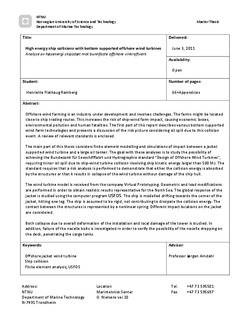| dc.contributor.author | Ramberg, Henriette Flathaug | nb_NO |
| dc.date.accessioned | 2014-12-19T12:06:44Z | |
| dc.date.available | 2014-12-19T12:06:44Z | |
| dc.date.created | 2012-02-09 | nb_NO |
| dc.date.issued | 2011 | nb_NO |
| dc.identifier | 495643 | nb_NO |
| dc.identifier.uri | http://hdl.handle.net/11250/237988 | |
| dc.description.abstract | Offshore wind farming is an industry under development and involves challenges. The farms might be located close to ship trading routes. This increases the risk of ship-wind farm impact, causing economic losses, environmental pollution and human fatalities. The first part of this report describes various bottom supported wind farm technologies and presents a discussion of the risk picture considering oil spill due to this collision event. A review of relevant standards is enclosed.
The main part of this thesis considers finite element modelling and simulations of impact between a jacket supported wind turbine and a large oil tanker. The goal with these analyses is to study the possibility of achieving the Bundesamt für Seeschifffahrt und Hydrographie standard "Design of Offshore Wind Turbines", requiring minor oil spill due to ship-wind turbine collision involving ship kinetic energy larger than 500 MJ. The standard requires that a risk analysis is performed to demonstrate that either the collision energy is absorbed by the structures or that it results in collapse of the wind turbine without damage of the ship hull.
The wind turbine model is received from the company Virtual Prototyping. Geometric and load modifications are performed in order to obtain realistic results representative for the North Sea. The global response of the jacket is studied using the computer program USFOS. The ship is modelled drifting towards the corner of the jacket, hitting one leg. The ship is assumed to be rigid, not contributing to dissipate the collision energy. The contact between the structures is represented by a nonlinear spring. Different impact locations on the jacket are considered.
Both collapse due to overall deformation of the installation and local damage of the tower is studied. In addition, failure of the nacelle bolts is investigated in order to verify the possibility of the nacelle dropping on the deck, penetrating the cargo tanks. | nb_NO |
| dc.language | eng | nb_NO |
| dc.publisher | Norges teknisk-naturvitenskapelige universitet, Fakultet for ingeniørvitenskap og teknologi, Institutt for marin teknikk | nb_NO |
| dc.title | High energy ship collisions with bottom supported offshore wind turbines | nb_NO |
| dc.title.alternative | Analyse av høyenergi skipsstøt mot bunnfaste offshore vinkraftverk<em> </em> | nb_NO |
| dc.type | Master thesis | nb_NO |
| dc.contributor.department | Norges teknisk-naturvitenskapelige universitet, Fakultet for ingeniørvitenskap og teknologi, Institutt for marin teknikk | nb_NO |
